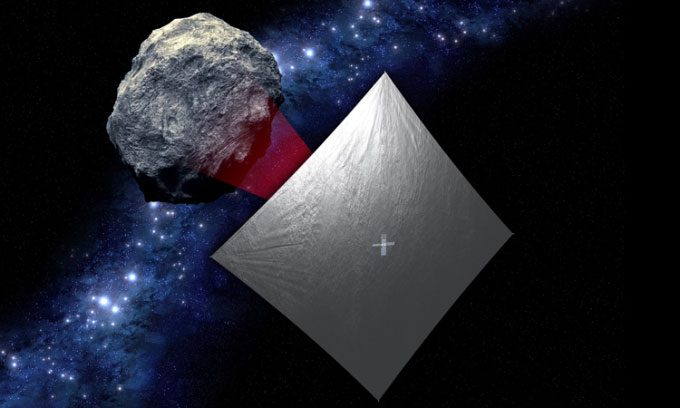The NEA Scout spacecraft, equipped with solar sail technology, will “visit” a small asteroid the size of a bus, measuring less than 18 meters in diameter.
NASA announced on January 20 that alongside the Artemis I launch, another spacecraft named Near Earth Asteroid Scout (NEA Scout) will also be heading into space. Artemis I is an uncrewed mission aimed at testing the Space Launch System (SLS) and the Orion spacecraft, paving the way for a program to return humans to the Moon.

Illustration of the NEA Scout spacecraft with its sail deployed as it passes by the target asteroid. (Image: NASA)
The NEA Scout is a compact cubesat. Its solar sail, made of ultra-thin plastic-coated aluminum, will expand to approximately 86 square meters when fully deployed. In contrast, the cubesat itself is only about the size of a shoebox.
The target of NEA Scout is 2020 GE, an asteroid estimated to be smaller than a bus, with a diameter of less than 18 meters. According to NASA, this will be the smallest asteroid ever studied by a spacecraft.
NEA Scout will travel to 2020 GE by deploying its solar sail and harnessing solar radiation for propulsion. This marks NASA’s first deep-space mission to be conducted in this manner. Solar sail technology is still relatively new. Contrary to its name, the spacecraft will rely on photon particles from the Sun rather than solar wind. The Planetary Society validated this technology with the launch of LightSail 2 in 2019.
NASA plans to study 2020 GE and determine whether it is a solid mass or a collection of tightly packed smaller rocks. “While larger asteroids are the biggest concern from a planetary defense perspective, objects like 2020 GE are far more common and pose a real risk to Earth, despite their smaller size,” said Julie Castillo-Rogez, a scientist involved in the NEA Scout mission.
Artemis I is scheduled to launch this year, potentially as early as March or April. If all goes well, NEA Scout will reach its target asteroid by the end of 2023.





















































